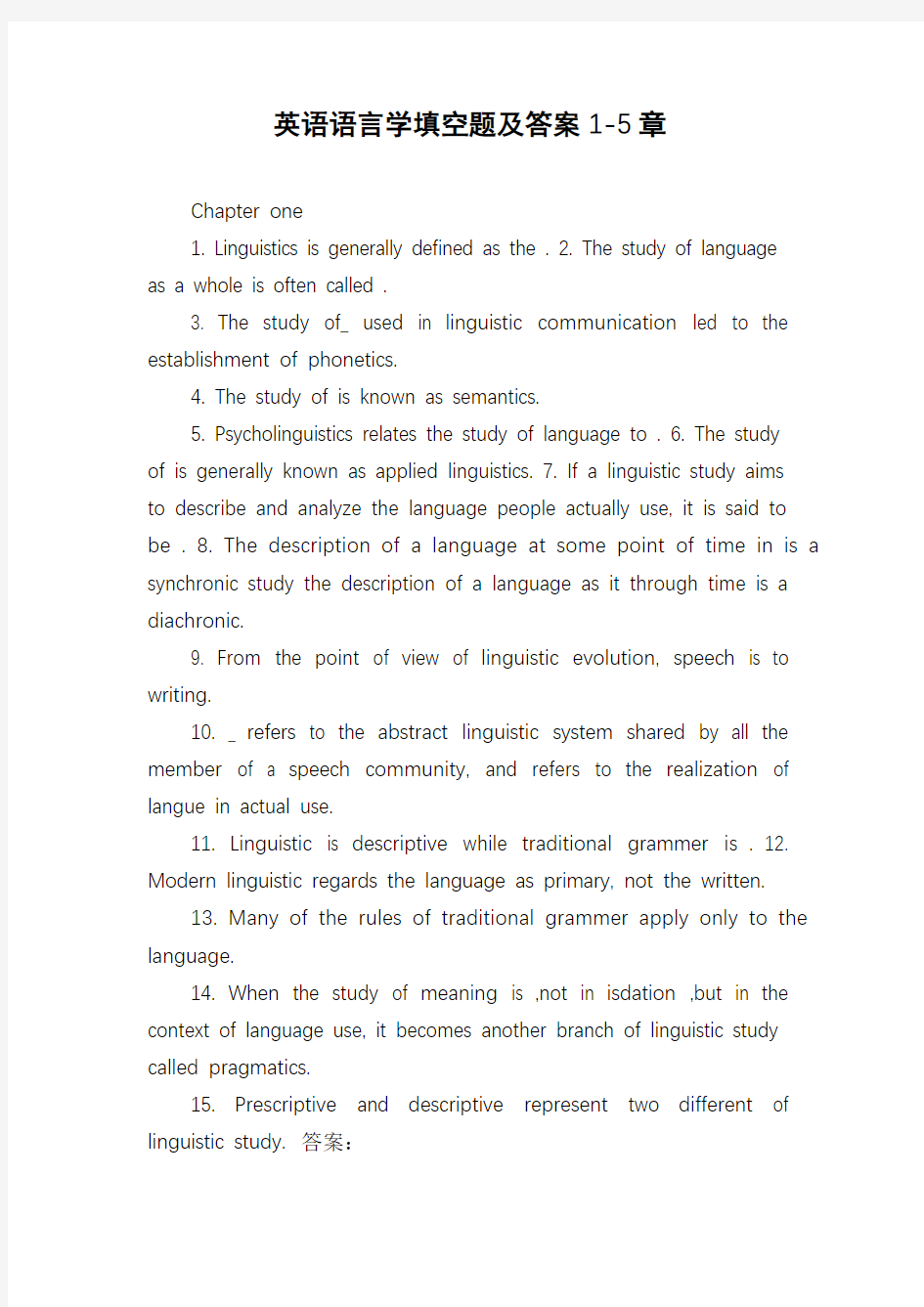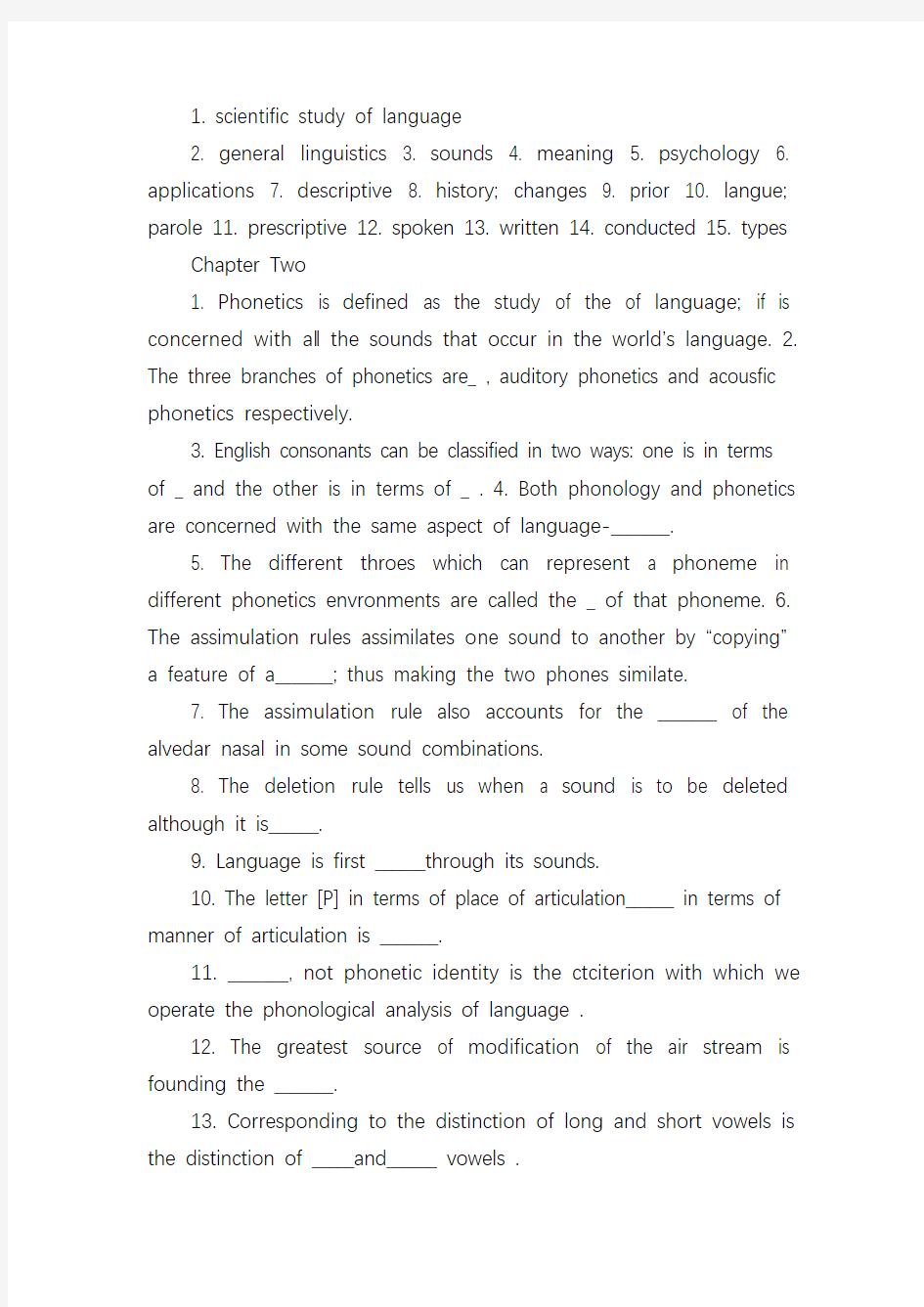英语语言学填空题及答案1-5章


英语语言学填空题及答案1-5章
Chapter one
1. Linguistics is generally defined as the .
2. The study of language as a whole is often called .
3. The study of_ used in linguistic communication led to the establishment of phonetics.
4. The study of is known as semantics.
5. Psycholinguistics relates the study of language to .
6. The study of is generally known as applied linguistics.
7. If a linguistic study aims to describe and analyze the language people actually use, it is said to be .
8. The description of a language at some point of time in is a synchronic study the description of a language as it through time is a diachronic.
9. From the point of view of linguistic evolution, speech is to writing.
10. _ refers to the abstract linguistic system shared by all the member of a speech community, and refers to the realization of langue in actual use.
11. Linguistic is descriptive while traditional grammer is . 12. Modern linguistic regards the language as primary, not the written.
13. Many of the rules of traditional grammer apply only to the language.
14. When the study of meaning is ,not in isdation ,but in the context of language use, it becomes another branch of linguistic study called pragmatics.
15. Prescriptive and descriptive represent two different of linguistic study. 答案:
1. scientific study of language
2. general linguistics
3. sounds
4. meaning
5. psychology
6. applications
7. descriptive
8. history; changes
9. prior 10. langue; parole 11. prescriptive 12. spoken 13. written 14. conducted 15. types Chapter Two
1. Phonetics is defined as the study of the of language; if is concerned with al l the sounds that occur in the world’s language.
2. The three branches of phonetics are_ , auditory phonetics and acousfic phonetics respectively.
3. English consonants can be classified in two ways: one is in terms of _ and the other is in terms of _ .
4. Both phonology and phonetics are concerned with the same aspect of language-_______.
5. The different throes which can represent a phoneme in different phonetics envronments are called the _ of that phoneme.
6. The assimulation rules assimilates o ne sound to another by “copying”
a feature of a_______; thus making the two phones similate.
7. The assimulation rule also accounts for the _______ of the alvedar nasal in some sound combinations.
8. The deletion rule tells us when a sound is to be deleted although it is______.
9. Language is first ______through its sounds.
10. The letter [P] in terms of place of articulation______ in terms of manner of articulation is _______.
11. _______, not phonetic identity is the ctciterion with which we operate the phonological analysis of language .
12. The greatest source of modification of the air stream is founding the _______.
13. Corresponding to the distinction of long and short vowels is the distinction of _____and______ vowels .
14. A phoneme is further analyzable because it consists of a set of______. 15. Similar alteration of stress also occurs between a ______and a phrase consisting of the same elements. 答案:
1. phonic medium
2. labeled articulation phonetics
3. manner of articulation; place of articulation
4. the speech sounds
5. allo phones
6. sequential phoneme
7. varying pronunciation
8. orthographically represented
9. perceived 10. bilabial; stops 11. phonetic similarity 12. oral cavity 13. tense; lox
14. simultaneous distinctive features 15. compound noun
Chapter Three
1. Linguists define the word as the smallest ______found in language.
2. Morpheme is the_______________ that carries information about meaning or function.
3. The root consistutes the _____ of the word and carries the major components of its meaning .
4. Morpheme are usually ______: there is no nature connection between their sound and meaning.
5. When _______ are conjoined to other morpheme (or words),
a new words are derived , or formed.
6. Derivation is an _______ that form a word with meaning and category distinct from that of its bases.
7. Unlike phonemes and syllables which are the elements of sound , words_______.
8. ______ are the foundation building blocks of a language .
9. Linguists use the term morphology to refer to the part of the grammer that is concerned with ______ and ________.
10. The content words of language , such as ____,_____,_____and adverbs, are sometimes called open class words.
11. Affixes______ belong to a lexical category and are always bound morpheme.
12. Bound morphemes which are for the most part purely grammatical makers and signify such concepts as tense, number, case are called_________.
13. _______, ________ and free morphemes combine are the major ways to produce new words.
14. The ways word are formed are called _______.
15. When two words are in the same _______, the compound will be in this category. 答案:
1. free form
2. smallest unit of language
3. core
4. arbitrary
5. derivational morphemes
6. affixational process
7. carry meaning
8. words
9. word formation; word structure 10. nouns; verbs; adjectives 11. do not
12. inflectional morphemes 13. derivation; compounds 14. morphological rules 15. grammatical category
Chapter four
1.To determine a word's category,three criteria are usually employed: , , .
2. The XP rule is .
3.Syntax is a branch of linguistics that studies the rules that .
4.The S rule is
5.The first, formed by the in accordance with the subcategorization properties, is called deep structure.
6.questions begin with a wh- word are called .
7.Corresponding to the final syntactic form of sentence which results from appropriate transformations , is called . 8.If the head is a verb, then the specifier is . 9.Word
level
categories are divided into
two kinds:
